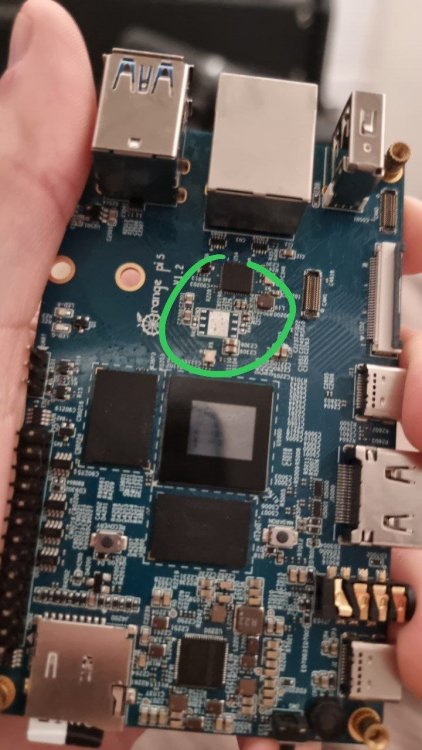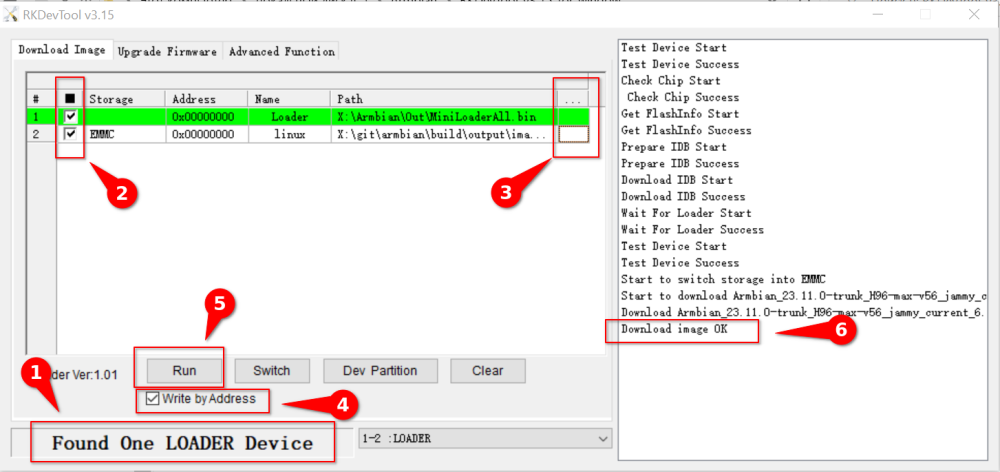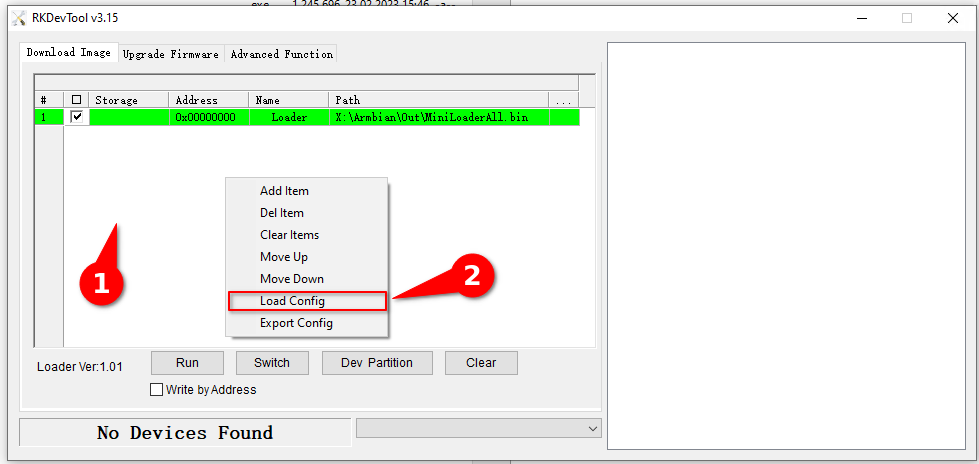Active threads
Showing topics posted in for the last 365 days.
- Past hour
-
Yes, DB9 won't work. But if, as eselarm mentions, a proper chip is on board already a simple usb-a to usb-c or c-to-c cable should do. Check dmesg when connection to see what pops up.
-
These things can happen, yes. Sometimes old vendor-style uboot cannot process a modern mainline kernel and vice versa. Glad to hear it worked well this time.
- Yesterday
-
Hi, I am currently using rock-5-itx to setup a NAS. Everything is working fine. uname -a: Linux amberbyte 6.1.75-vendor-rk35xx #1 SMP Thu Nov 28 03:16:11 UTC 2024 aarch64 GNU/Linux Now, I wanted to update RKNPU version from 0.9.7 to 0.9.8. So, again I recompiled the image with the updated drivers. Using Pi-imager flashed it onto an SD card. When I tried to boot I am getting the following error message from the serial output: ./compile.sh build BOARD=rock-5-itx BRANCH=vendor BUILD_DESKTOP=no BUILD_MINIMAL=yes EXPERT=yes KERNEL_CONFIGURE=yes RELEASE=bookworm DDR 9fffbe1e78 cym 24/02/04-10:09:20,fwver: v1.16 LPDDR5, 2400MHz channel[0] BW=16 Col=10 Bk=16 CS0 Row=16 CS1 Row=16 CS=2 Die BW=16 Size=4096MB channel[1] BW=16 Col=10 Bk=16 CS0 Row=16 CS1 Row=16 CS=2 Die BW=16 Size=4096MB channel[2] BW=16 Col=10 Bk=16 CS0 Row=16 CS1 Row=16 CS=2 Die BW=16 Size=4096MB channel[3] BW=16 Col=10 Bk=16 CS0 Row=16 CS1 Row=16 CS=2 Die BW=16 Size=4096MB Manufacturer ID:CH0 RX Vref:26.3%, TX Vref:21.0%,21.0% CH1 RX Vref:27.1%, TX Vref:22.0%,22.0% CH2 RX Vref:27.1%, TX Vref:24.0%,21.0% CH3 RX Vref:27.5%, TX Vref:21.0%,20.0% change to F1: 534MHz change to F2: 1320MHz change to F3: 1968MHz change to F0: 2400MHz out U-Boot SPL board init U-Boot SPL 2017.09-armbian-2017.09-S2284-P8c48-Hfac6-Ve5ad-Bda0a-R448a (Nov 20 2024 - 17:06:35) Trying to boot from MMC2 spl: partition error Trying fit image at 0x4000 sector ## Verified-boot: 0 ## Checking atf-1 0x00040000 ... sha256(7612223b82...) + OK ## Checking uboot 0x00200000 ... sha256(af1962bdff...) + OK ## Checking fdt 0x00324010 ... sha256(e3b0c44298...) + OK fdt_record_loadable: FDT_ERR_BADMAGIC ## Checking atf-2 0xff100000 ... sha256(70505bb764...) + OK fdt_record_loadable: FDT_ERR_BADMAGIC ## Checking atf-3 0x000f0000 ... sha256(b2af21b504...) + OK fdt_record_loadable: FDT_ERR_BADMAGIC Jumping to U-Boot(0x00200000) via ARM Trusted Firmware(0x00040000) Total: 813.644/1063.106 ms INFO: Preloader serial: 2 NOTICE: BL31: v2.3():v2.3-868-g040d2de11:derrick.huang, fwver: v1.48 NOTICE: BL31: Built : 15:02:44, Dec 19 2024 INFO: spec: 0x1 INFO: code: 0x88 INFO: ext 32k is not valid INFO: ddr: stride-en 4CH INFO: GICv3 without legacy support detected. INFO: ARM GICv3 driver initialized in EL3 INFO: valid_cpu_msk=0xff bcore0_rst = 0x0, bcore1_rst = 0x0 INFO: l3 cache partition cfg-0 INFO: system boots from cpu-hwid-0 INFO: disable memory repair INFO: idle_st=0x21fff, pd_st=0x11fff9, repair_st=0xfff70001 INFO: dfs DDR fsp_params[0].freq_mhz= 2400MHz INFO: dfs DDR fsp_params[1].freq_mhz= 534MHz INFO: dfs DDR fsp_params[2].freq_mhz= 1320MHz INFO: dfs DDR fsp_params[3].freq_mhz= 1968MHz INFO: BL31: Initialising Exception Handling Framework INFO: BL31: Initializing runtime services WARNING: No OPTEE provided by BL2 boot loader, Booting device without OPTEE initialization. SMC`s destined for OPTEE will return SMC_UNK ERROR: Error initializing runtime service opteed_fast INFO: BL31: Preparing for EL3 exit to normal world INFO: Entry point address = 0x200000 INFO: SPSR = 0x3c9 No valid device tree binary found - please append one to U-Boot binary, use u-boot-dtb.bin or define CONFIG_OF_EMBED. For sandbox, use -d <file.dtb> initcall sequence 00000000002b8500 failed at call 00000000002aaf6c (err=-1) ### ERROR ### Please RESET the board ### I get the same error when I use the desktop image too: ./compile.sh build BOARD=rock-5-itx BRANCH=vendor BUILD_DESKTOP=yes BUILD_MINIMAL=no DESKTOP_APPGROUPS_SELECTED='browsers desktop_tools internet programming' DESKTOP_ENVIRONMENT=gnome DESKTOP_ENVIRONMENT_CONFIG_NAME=config_base EXPERT=yes KERNEL_CONFIGURE=yes RELEASE=bookworm But when I use the image downloaded from the armbian website is getting booted up without any issue and it has updated RKNPU drivers. But I have to build a kernel because I want the LSI MEGARAID drivers enabled. Also when I want to make RKNPU driver modular <M> it is unable to finish building the image with an error saying it is unable to find rknpu.ko. So, why is this happenning and is there a way to update the drivers without going through building the kernel? Thank you in advance and any help will be helpful.
-
Hey guys! Sorry it's been a while since the last update, here comes a good story with a sad ending hahah Ok, so! That's what I've done so far! Since i had to order some UART devices to check if I did get any output, it took a bit longer than expected, then i left the project on the sidelines, until... i got a hot air rework gun, so yeah I bought some SPI chips on the cheap and a programmer and did a test and succesfully wrote on them an read on them the binary file, so I proceded to completely desolder the SPI chip from the Orange Pi 5 and surprise!, The SPI was completely unreadable or unwritable, so we got that part right, SPI is dead. I thought that after removing the dead chip i might have some more luck with the UART device and tried to read info from it again... but no luck, nothing came out of it, so I thought I might be doing something wrong. The device is still stuck in maskrom mode. It goes straight to maskrom mode when you power it on, I also checked for shorts on the diodes or the press buttons, but they are all good. After a lot of chitchat with Gemini I tried to reflash the miniloaderall.bin from the website and suprise surprise, the miniloader, when booting the board pressing the maskrom mode manually, allowed to download the .bin file to the orange pi, BUT still no image, but If i do that I get something on the UART device. I get this funky message, according to the AI it seems that the CPU chip might be good but it can't read the RAM chips on the board, doesn't reach to that point and that would explain why it doesnt even try to boot from a microsd card anyway. So, my options are kinda bad now, it could either be a bad ball soldered on to the CPU chip that gets errors on reading the ram, or most likely a bad RAM chip on the board, problem is, at least according to the AI that soldering RAM chips with a soldering station without a pre heating board, its quite stresful for such delicate components, that I could easily break them by overheat and then I would not be able to repair the board anymore, obviously I tried all that as a learning process and I'm glad how far I've come, if anyone has any other idea or any suggestion, I could try that, I'm still thinking about going for the RAM desoldering process but I would need some replacements and if the risk of breaking those is that high might not be worth going as far as that. BTW the SPI chips i bought have the wrong package size and are like 2mm wider than the Orange Pi 5 layout and it doesn't fit, so I could not try to solder the new SPI chip back in, I would need to order some more with the correct package size, no big deal, SPI chip is cheap, ram chips are not as cheap.
-

CSC Armbian for RK322x TV box boards
Vinicius Guastala replied to jock's topic in Rockchip CPU Boxes
and I must say that not only your passion, but also your dedication and commitment are truly inspiring for the whole community! One just cannot thank you guys for everything you have done! @fabiobassa @jock @ilmich Since @jock provided the experimental image on May 12th, i've been playing non-stop with this device, doing numerous flashing attempts and testing things out, just for fun... I must have spent 30+ hours on this ever since, mostly trying to compile things myself to run in the box, playing with the different overlays to test what works and what doesn't and learning about Tee, trust, op-tee,... You know those kids that when get their toys, they tear it apart instead? well... same feeling... the discovery passion thing... I'm preparing a report on my findings for my specific "MXQ-EP-2-V1.0" MoBo model, specially around on the working overlays, perhaps I can post it in the weekend.... And responding to my own question earlier about armbian minimal, in the armbian-config tool from the experimental image, there is an option to disable desktop... it gives you a system with only 25 tasks running and lower RAM usage than a DietPi. Now I begin to become interested on (re)assembling ROM images... I've been trying to replace some internet roms with the Trust Partitions and u-boot from the ROM I know it works... No successful test yet, but not sure if I'm repacking them correctly... Anyway, I'm learning a lot and that's great thanks to this community! -

CSC Armbian for RK3318/RK3328 TV box boards
Андрей Димов replied to jock's topic in Rockchip CPU Boxes
Incbot, hi I have this problem too. Use rk3318-config command to set device tree overlay (on the second step push space then enter) and then don't touch device tree overlay in armbian-config. After reboot use command hciconfig -a, if it have some message on screen - Bluetooth working -

TVBOX M4xq with ik316 EMCP 1.0
Aleqssandro Farias replied to javaxsousa's topic in Allwinner CPU Boxes
Hi @Nick A, good afternoon! Yes, I tested them — I tried all three ISOs you shared. I'm sending you the UART logs from two of them: the one you specifically asked me to test and the MiniArch one. The one you asked me to try throws a DRAM error, while the MiniArch image actually boots — maybe because it’s configured for eMCP. log_miniarch.txt log_armbian_unofficial.txt -
Hi everyone, I'm recently obtained a TV box from a local store (seems like they sell Amazon returns or something, but they just have a bunch of random stuff). After installing AIDA64, I learned that it's running an Allwinner H616 CPU and has 4GB of RAM. It is able to boot warpme's MiniArch build for the Tanix TX6S, and I extracted the DTB from the Android build on the eMMC. My question is, where do I go from here? I'd like to build a custom Armbian image to support my device. When I try booting the Armbian image for the Orange Pi Zero 2, it gives an error over my serial monitor about a bad DRAM configuration which I expected since apparently these boxes have DRAM chips that are often laid out differently than the Orange Pi, and this can apparently be fixed with a U-boot configuration change. I was curious about how I can integrate these changes into my own build of Armbian so I could bring support to my device. Thanks in advance!
-

How to install armbian in h618?
Алексей Торопов replied to alienxz77b's topic in Allwinner CPU Boxes
Thank you, I tried. But this is not my level, it is too difficult for me. I'll probably wait for your next release. -
I believe I have the same issue with an unbootable Rock64 after the kernel update from 6.6.x to 6.12.x.
-
Good day, I've installed ARMBIAN to my old TV box. It's running fine as I ussually use it headles with a ssh connection to it. BUT NOW I've attached it to the hdmi TV and I want to remotely use that HDMI screen w/o local keyboard and mouse. I don't know how to do that. Please give me a help?
-
Yeah, I noticed it was not rebuilt on the next calls to compile.sh. Might not solve the problem for CI/CD environments, but for development it should work. Thanks!
-

Efforts to develop firmware for H96 MAX M9 RK3576 TV Box 8G/128G
cmuki replied to Hqnicolas's topic in Rockchip CPU Boxes
Hey, @xiaobao80! Sadly not - but on the upside I was able to build and use the latest kernel. Also want to update and say that I did manage to use the NPU and the VPU successfully with Immich AI facial recognition and Jellyfin transcoding respectively. -

Efforts to develop firmware for H96 MAX V56 RK3566 8G/64G
Hqnicolas replied to Hqnicolas's topic in Rockchip CPU Boxes
-
Finally someone has the question I wanted to ask right now.. Thank you for the solution you found. I will try it sir..
-
Makes sense, thanks for pointing that out. I had similar issues and I’ll check which package holds it on my setup and try replacing it. Hopefully that clears it up.. Thank you..
-

No Audio on Kernel: 6.12.15 and Armbian 25.2.2 Bookworm Minimal
brentr replied to Truenox's topic in Radxa Rock Pi S
Further testing shows that Armbian 25.2.x through the current version all run the arecord -c 2 -r 192000 -f S32_LE test.wav without error, PROVIDED the 6.12.12 kernel is used. But, any kernel version after 6.12.12 fails. Now I've just got to find out what broke in 6.12.13 🙂 -
You can find this information on the Rock Pi S PoE Hat Wiki, but you need to write some GPIO values to enable the headphone jack. # echo 15 > /sys/class/gpio/export # echo out > /sys/class/gpio/gpio15/direction # echo 1 > /sys/class/gpio/gpio15/value To persist this across reboots you can create a `systemd-tmpfile` at `/etc/tmpfiles.d/enable-audio-jack.conf` with the following contents. w /sys/class/gpio/export - - - - 15 w /sys/class/gpio/gpio15/direction - - - - out w /sys/class/gpio/gpio15/value - - - - 1
-

Audio no longer works after updating to Armbian 24.8.2
PHLAK replied to PHLAK's topic in Radxa Rock Pi S
I just updated one of my Armbian installs, including the 6.12.22 kernel, and it's still working normally. $ uname -a Linux snapclient-master-bedroom 6.12.22-current-rockchip64 #1 SMP PREEMPT Mon Apr 7 08:08:37 UTC 2025 aarch64 GNU/Linux $ aplay -l **** List of PLAYBACK Hardware Devices **** card 0: analog [analog], device 0: ff320000.i2s-rk3308-hifi ff560000.codec-0 [ff320000.i2s-rk3308-hifi ff560000.codec-0] Subdevices: 1/1 Subdevice #0: subdevice #0 card 1: pcm5102a [pcm5102a], device 0: ff300000.i2s-pcm5102a-hifi pcm5102a-hifi-0 [ff300000.i2s-pcm5102a-hifi pcm5102a-hifi-0] Subdevices: 1/1 Subdevice #0: subdevice #0 - Last week
-
I also have some oom issues when doing an aptitude upgrade in my opizero w/256 MiB ram. Guess even more on a 128MiB board like yours. Best to add a swap file to make sure upgrades go without issue. Grt,
-
I'm building a multi-zone music streaming setup built around an SBCs running Snapcast/MPD and this MA12070P board (AliExpress link). From the pinout diagrams it looks like the board is the same as the Merus Audio Amp Hat just with a built in USB-C PD supply (why I want to use this board). If it's a clone then it looks like support is in Raspberry Pi OS, but I want to use the Radxa Zero 3W since I can get it at a similar price point with better specs. This is my first embedded project since ~2019 so a bit out of my depth when it comes to device tree overlays. How would I write a DTO to enable audio output to this device?
-
After installing official Armbian_25.2.1_Orangepi5-plus_bookworm_vendor_6.1.99_xfce_desktop.img to sdcard, then to nvme all is fine, until, I do an apt update & upgrade, after that point chromium fails to run. I explored the logs to see it a failure to load chromium.conf from /etc/chromium.d/chromium.config (failed symbolic link to /etc/armbian/chromium.config). Is there a known workaround besides utilization of firefox?
-
Finally got around to debug this: Previously I had the system on an nvme drive and the bootloader on spi After reinstalling the system and bootloader both on mmc flash, I eventually ran into the very same issue. According to the logs, the boot bails with the following error: Log1: When I remove the nvme drive, the boot process works just fine for some reason: (boot log after nvme removal) Log2: When I reinstall the nvme, the boot fails again. However, booting from sd-card (using recovery button) and reflashing the bootloader to the mmc fixes the issue as well with the same result as removing the nvme drive had, resulting in the same log2 as above. I had fixed the issue before by reflashing the bootloader to spi but just like yesterday, it eventually stopped booting again until I reflashed the boot loader. There isn't anything particular happening before this occurs, though the last few times it was always after the system had run for some time. After cutting power (without shutdown) and booting it again, the issue would appear. (The device is always cut from power instead of shutting it down, but there was never an error on any drive due to that). The issue also did not show when the device was just turned of (without power) for a day or two. It seems to trigger quite randomly. I already tried to erase the spi flash to avoid any old entries messing up the boot order but without effect. Any clue what I could try next?
-

Analog Audio out not working (25.2.1 / 6.1 kernel / KDE Neon)
deskwizard replied to deskwizard's topic in Orange Pi 5
The OPi5 uses an es8388 for the analog audio out. I don't know about the OPi5Max or other boards for that matter, as I don't own any other relevant SBC. Good luck! -
Good afternoon jock! I'm asking for your help again. The X88 pro 10 128 Gb(X88 PRO-B-RK3318-D4-V1.6) box does not want to work with an LED screen. Arabian-config led-config2 is set, the screen does not respond. There is no display folder in the /sys/class/leds directory. When installing the led-config5, the service works, the check starts, but the display does not light up at all! How do I set it up? Box H96 max It works great on this version and led-config5. 4.036378] spi_gpio i2c-aux-display: cs36 >= max 1 [ 4.036421] spi_master spi0: spi_device register error /i2c-aux-display/aux-display-controller@24 [ 4.036471] spi_master spi0: Failed to create SPI device for /i2c-aux-display/aux-display-controller@24 v24.11 rolling for RK3318 Box running Armbian Linux 6.11.5-edge-rockchip64 Packages: Debian stable (bookworm) Support: for advanced users (rolling release) Performance: Load: 32% Up time: 12 min Memory usage: 17% of 3.88G CPU temp: 59°C Usage of /: 6% of 114G I attached a photo of the led display chip (the outputs from the led display go to it) AIP16283BT35 (maybe it tm1628 ?) IMG_4802.heic









